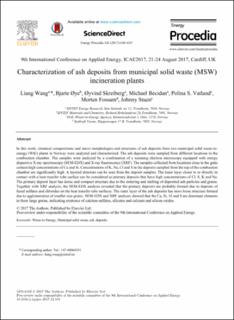| dc.contributor.author | Wang, Liang | |
| dc.contributor.author | Øye, Bjarte Arne | |
| dc.contributor.author | Skreiberg, Øyvind | |
| dc.contributor.author | Becidan, Michael | |
| dc.contributor.author | Vatland, Polina | |
| dc.contributor.author | Fossum, Morten | |
| dc.contributor.author | Stuen, Johnny | |
| dc.date.accessioned | 2020-12-16T13:30:24Z | |
| dc.date.available | 2020-12-16T13:30:24Z | |
| dc.date.created | 2017-08-27T16:33:04Z | |
| dc.date.issued | 2017 | |
| dc.identifier.citation | Energy Procedia. 2017, 142 630-635. | en_US |
| dc.identifier.issn | 1876-6102 | |
| dc.identifier.uri | https://hdl.handle.net/11250/2719858 | |
| dc.description.abstract | In this work, chemical compositions and micro morphologies and structures of ash deposits from two municipal solid waste-to-energy (WtE) plants in Norway were analyzed and characterized. The ash deposits were sampled from different locations in the combustion chamber. The samples were analyzed by a combination of a scanning electron microscopy equipped with energy dispersive X-ray spectroscopy (SEM-EDX) and X-ray fluorescence (XRF). The samples collected from locations close to the grate contain high concentrations of Ca and Si. Concentrations of K, Na, Cl and S in the deposits sampled from the top of the combustion chamber are significantly high. A layered structure can be seen from the deposit samples. The inner layer closer to or directly in contact with a heat transfer tube surface can be considered as primary deposits that have high concentrations of Cl, S, K and Na. The primary deposit layer has dense and compact structure due to the sintering and melting of deposited ash particles and grains. Together with XRF analysis, the SEM-EDX analysis revealed that the primary deposits are probably formed due to deposits of fused sulfates and chlorides on the heat transfer tube surfaces. The outer layer of the ash deposits has more loose structure formed due to agglomeration of smaller size grains. SEM-EDX and XRF analyses showed that the Ca, Si, Al and S are dominant elements in these large grains, indicating existence of calcium sulfates, silicates and calcium and silicon oxides. | en_US |
| dc.language.iso | eng | en_US |
| dc.publisher | Elsevier | en_US |
| dc.rights | Attribution-NonCommercial-NoDerivatives 4.0 Internasjonal | * |
| dc.rights.uri | http://creativecommons.org/licenses/by-nc-nd/4.0/deed.no | * |
| dc.subject | deposits | en_US |
| dc.subject | ash | en_US |
| dc.subject | Municipal solid waste | en_US |
| dc.subject | Waste-to-Energy | en_US |
| dc.title | Characterization of ash deposits from municipal solid Waste (MSW) incineration plants | en_US |
| dc.type | Peer reviewed | en_US |
| dc.type | Journal article | en_US |
| dc.description.version | publishedVersion | en_US |
| dc.rights.holder | © 2017 The Authors. Published by Elsevier Ltd. | en_US |
| dc.source.pagenumber | 630-635 | en_US |
| dc.source.volume | 142 | en_US |
| dc.source.journal | Energy Procedia | en_US |
| dc.identifier.doi | 10.1016/j.egypro.2017.12.104 | |
| dc.identifier.cristin | 1488871 | |
| dc.relation.project | Norges forskningsråd: 193817 | en_US |
| cristin.unitcode | 7548,70,0,0 | |
| cristin.unitcode | 7401,80,4,4 | |
| cristin.unitname | Termisk energi | |
| cristin.unitname | Elektrolyse og høytemperaturmaterialer | |
| cristin.ispublished | true | |
| cristin.fulltext | original | |
| cristin.qualitycode | 1 | |

